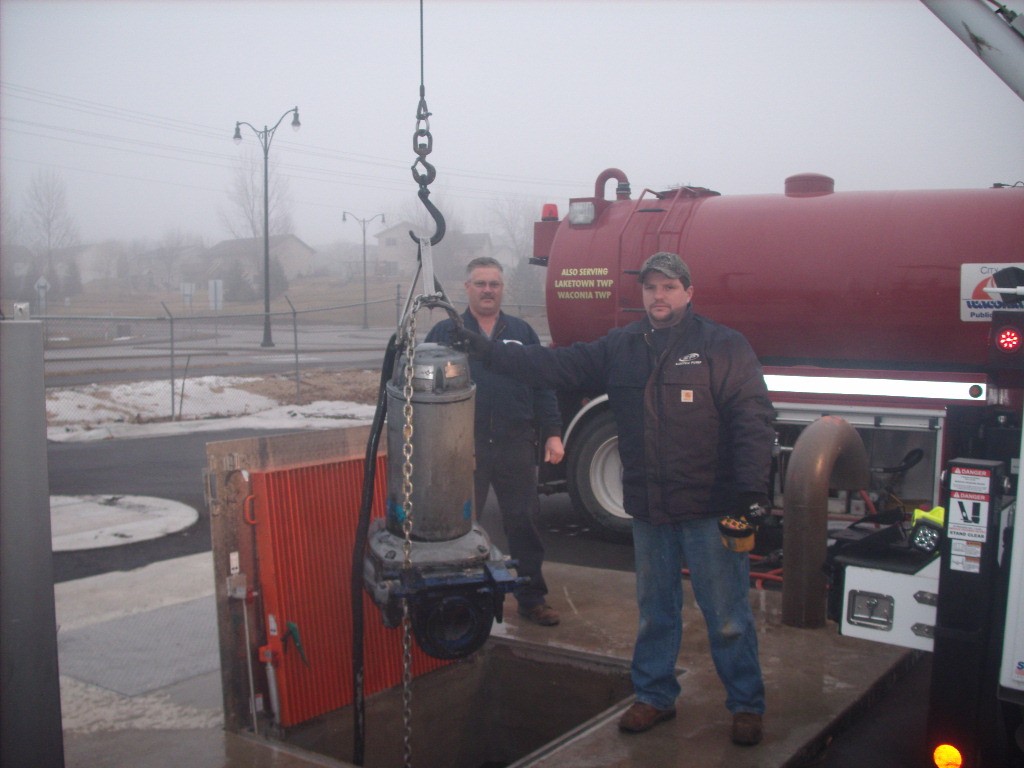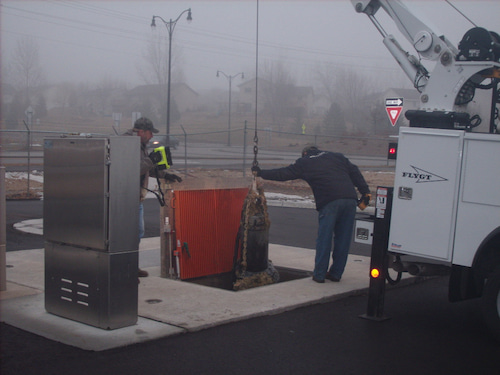Minnesota utility responds to increasing pump clogging problems.
A new-generation of “disposable” products largely created a recurring bottleneck at a strategic lift station along the sanitary sewer collection system for the City of Waconia, Minn. The pumping facility is among 12 others along the collection system where the pumps clogged frequently during a 2- to 3-year period before uniquely engineered replacement pumps cleared the problem.
The Clogging Problem
The incidents became both an efficiency and cost issue because the clogging occurred often after normal working hours when outsourced crews were called in at overtime rates, according to Doug Bode, Waconia’s utilities maintenance supervisor.
“We had 18 daytime pump clogging events and 16 at night that required pulling at least one of the two pumps during the 10-month period before we replaced them,” Bode said. “As a temporary solution, we tried freeing the impeller on one of the pumps by reversing its rotation twice a day from October 2010 through January of 2011. It would clear the impeller clog and keep the facility operating at capacity but was very hard on the pump. The pump put up a good fight before it finally wore out on us.”
The station receives a flow that is concentrated with solids from a long stretch of residential gravity systems without other lift stations up line from it, Bode explained. Starting about 3 years ago, he noted, the impellers would become repeatedly entangled with stringy “flushable” debris carried into the station. When that happened, the drag on a station’s pumps would also sap the energy efficiency until the pump entirely clogged and tripped off.
“It became an expensive problem,” he said. “We spent $14,027 on pulling the pumps and on rebuilding one unit. It could cost the utility up to $300 per clogging incident when we contracted a night-hour outage to an outsource crew at their overtime rate.”

Doug Bode, maintenance supervisor, (background) with one of two 70-horsepower pumps pulled from the duplex station’s wetwell by a technician

One of two 70-horsepower pumps being reset into the duplex station following inspection
The Cause of the Ragging
Bode’s utility is among the latest to combat recurring pump blockages attributed to the waste material that originates as wet-impregnated and dry-electrostatic wipes used as protectant, cleaning, personal hygiene and household cleaning products. Unlike woven material, the flat, porous sheets are made directly from separate non-woven fibers or from molten plastic or plastic film. Manufacturers market the wipes as single-use, “disposable” products, but the general public mistakenly perceives them as equally “flushable.”
While the tissue-like wipes offer convenience and rarely obstruct residential sewer lines, they can strangle traditional lift station pumps as the residual material builds up on an impeller. The ragging impedes or totally clogs the pump intakes. This spreading problem could become as notorious in the wastewater utilities industry as disposable diapers were decades ago in blocking line and treatment plant flows.
Some of the problem may be perception. The public could relate more easily to the threat of disposable diapers obstructing sewer lines because they were larger than the more recent convenience products. Many households gained a firsthand appreciation of the problem after paying a plumber to clear their lines of disposable diapers.
Wipes are a much smaller and insidious family of convenience products. Federal legislation that reduced the flush volume for residential plumbing fixtures to 1.6 gallons has only aggravated the problem. It could take more than billing inserts to raise public awareness that single-use wipes may be “flushable” but not always “flowable.”
A few state lawmakers have proposed a ban on the marketing of such products, prodding trade organizations to react. A 2008 report by the U.S.-based Association of Nonwoven Fabrics Industry (INDA), addressed how wipes that pass through residential sewers should flow equally through the wastewater collection systems and be compatible with accepted wastewater treatment plant operations. INDA and ENDA, the European counterpart, have since drafted guidelines to establish what constitutes a flushable consumer product. The National Sanitary Foundation (NSF) sponsors an independent validation service to test and certify a consumer product’s “flushability” based on a toilet bowl and drain-line test, a “dispersability test,” a column settling test and aerobic and anaerobic disintegration tests.
Waconia Growth Brings an Exponential Problem
Located 40 miles west of Minneapolis, Waconia has a population of 10,000 residents served by a sewer collection system that entered service in the early 1960s. Excluding the force mains, the collection system consists of approximately 55 miles of PVC gravity lines that are up to 20 inches in diameter. The duplex lift station that experienced the blockages had been rebuilt and enlarged from a 9-foot by 9-foot by 28-foot station to a 12-foot by 12-foot by 43-foot facility designed to handle 1,350 gallons per minute. The other duplex stations in the Waconia system are the same and include 3-horsepower, 5-horsepower, 20-horsepower and 85-horsepower pumps. The pumps are equipped with variable frequency drives (VFDs) and individual electric meters.
The station serves a large residential development area and gains additional storage from an 11-foot-diameter line. A supervisory control and data acquisition (SCADA) system and controllers by the same manufacturer as the replacement pumps provide prompt response and protection against SSOs.
When the large stations clogged, four maintenance personnel were usually needed onsite to safely restore the stations to operation. The facility that received the replacement pumps eventually presented intolerable cost and man-hour requirements, according to Bode.
“We had some issues even before so many different wipes and other disposable products became so popular,” Bode said. “We initially cleaned the wet wells with a vacuum truck that handled the built-up ragging but the stringy material eventually became a major problem for the pumps, particularly at that major facility.”
Pump Upgrade with Self-Cleaning Pumps
Waconia set out to upgrade the facility with higher performance pumps that were resistant to the recurring clogging. Bode began working with an area distributor to analyze the options available to stop the blockages and maintain the desired 1,350-gallon-per-minute handling ability.
The analysis and modeling data indicated 70-horsepower, self-cleaning pumps would resolve the utility’s clogging problem, meet the 110 feet of head and deliver 15 percent greater efficiency despite having smaller horsepower motors than the existing 85-horsepower units that were previously used. The proposed replacement pumps had a history of correcting clogging issues at pump stations and in wastewater treatment plants operated by sewer utilities in other areas of the U.S.

The replacement pump was a specifically-designed response to the growing challenges of today’s wastewater flows that have higher content levels of debris. It handles solids more efficiently than a chopper pump. The engineering features that drive the improved efficiency are a self-cleaning, semi-open, back-swept impeller with a horizontally-positioned vane that delivers superior hydraulic efficiency while achieving energy savings up to 55 percent.
The design eases the passage of solids while self-cleaning the edges of the unit’s impeller with each revolution. By eliminating ragging, the pump prevents the steady build up of fibrous material that imposes drag on the impeller and constriction of the intake that compromise respective energy usage and operating efficiency.
“The station has operated flawlessly ever since the Flygt N-pumps were installed, eliminating the clogging problem and noticeably reducing the station’s kilowatt-per-hour usage,” Bode added. “Several other stations have been equipped with the new pump and our future plans are to upgrade all 13 of our stations with the same type units.”
P&S

